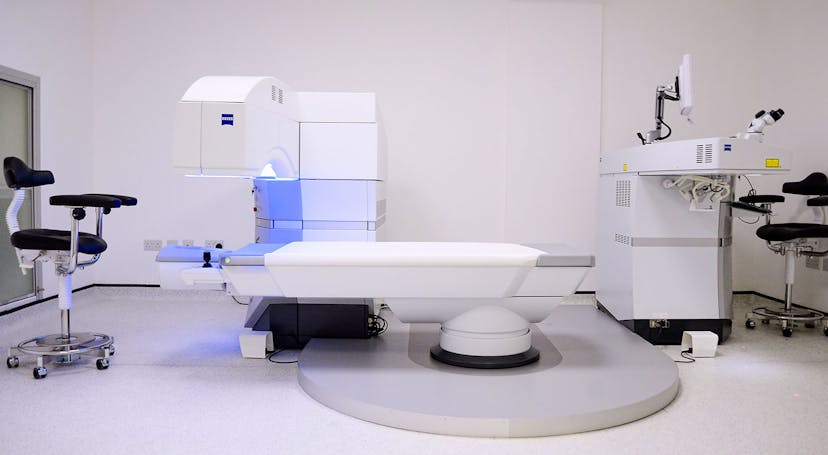
On the day of the ReLEx SMILE operation, you will arrive at the time given to you. It’s best not to wear eye makeup or to put any drops in the eye. The reception staff will check your details and then you will be shown to the laser suite where the surgical staff will be.
Once ready you will be escorted into the laser room. You will lie down on the laser trolley and the surgeon will move you into position under the laser.
A drop of anaesthetic is placed on your cornea and a clip is placed between your lids to hold them open. The surgeon will be giving verbal instructions during all this time.
You will be asked to stare at the blue light to hold your gaze in the correct place. Slowly the laser machine will manoeuvre you into the precise position while you stare at the blue light. Then the laser machine will make contact with your eye with a gentle kiss.

27 Seconds
When everything is ready the laser starts and approximately 27 seconds later the laser procedure is finished. The surgeon removes the lenticule carved by the laser. Then the exact same procedure is carried out on the other eye.
When all is finished the trolley will be brought back to the rest position and you can sit up and begin to check out your new vision.
In SMILE (Small Incision Lenticule Extraction) laser eye surgery, the entire procedure is designed to be quick and minimally invasive. Here's a step-by-step explanation of what happens in approximately 27 seconds during a SMILE procedure:
- Preparation (Seconds 1-5):
- The patient is positioned comfortably on the surgical bed.
- Anaesthetic eye drops are administered to numb the eye's surface, ensuring the patient doesn't feel any pain during the procedure.
- A small device called a speculum is used to gently hold the eyelids open, keeping the eye steady and preventing blinking.
- Creating the Lenticule (Seconds 6-14):
- A femtosecond laser is used to create a precise, microscopic lenticule (a small disc-shaped piece of corneal tissue) within the cornea. This laser emits extremely short, ultra-fast pulses of light.
- The laser works at an incredibly high speed, making it possible to complete this step in a matter of seconds.
- Removing the Lenticule (Seconds 15-24):
- After the lenticule is created, a small incision is made on the surface of the cornea, typically around 2 to 4 millimetres in length. This incision is much smaller than those used in traditional LASIK surgery.
- The surgeon then uses a specially designed instrument to gently remove the lenticule through the small incision. This reshapes the cornea, correcting the refractive error.
- Completing the Procedure (Seconds 25-27):
- With the lenticule removed, the cornea's shape is now optimized to correct the patient's vision. The incision is so small that it typically heals without the need for stitches.
- The entire SMILE procedure for one eye is completed in just a few seconds.
| Step | Duration (Seconds) | Description |
|---|---|---|
| 1 | 5 | Preparation (Anesthetic drops, speculum) |
| 2 | 9 | Creating the Lenticule (Femtosecond laser) |
| 3 | 10 | Removing the Lenticule (Incision, lenticule removal) |
| 4 | 3 | Completing the Procedure (Final adjustments) |
Furthermore, the entire surgical process, including the preparation and recovery, takes longer than the actual laser application. The surgeon will provide instructions for post-operative care, and patients usually experience rapid visual recovery after SMILE surgery. Remember, this description provides an overview of the process, but the actual timing can vary depending on the specific circumstances and the surgeon's technique. Always consult with a qualified ophthalmologist for precise details about any surgical procedure.
Why Is Laser Eye Surgery Fast?
Laser eye surgery is considered a fast procedure because it typically takes only a few minutes to complete. There are several reasons why laser eye surgery is relatively quick:
- Precision of Laser Technology: The surgery itself is performed with the help of advanced laser technology. The lasers used in procedures like ReLEx SMILE are extremely precise, allowing for highly accurate corrections to the cornea.
- Minimally Invasive: Laser eye surgery is a minimally invasive procedure. It does not involve large incisions or extensive tissue manipulation, which reduces the time needed for the surgery.
- Automated Processes: Many steps in the laser eye surgery process are automated. For example, the laser system may be programmed to perform the necessary adjustments to the cornea based on the individual's prescription.
- Advanced Imaging Technology: Prior to the surgery, detailed maps of the cornea are created using advanced imaging technology. These maps guide the laser in making precise corrections.
- Experienced Surgeons: Surgeons who perform laser eye surgery are highly skilled and experienced. They are trained to efficiently perform the procedure without compromising on safety or precision.
- High Success Rates: The success rates of laser eye surgery are very high, which means that complications are relatively rare. This allows for a streamlined and efficient surgical process.
- Minimal Discomfort: Patients are typically given numbing eye drops, so they do not experience pain during the procedure. This helps maintain patient comfort and allows for a smooth surgical experience.
- Short Recovery Time: After the surgery, most patients experience rapid recovery, with many noticing improved vision within hours. This quick recovery contributes to the perception of the surgery as a fast procedure.
Moreover, while the surgery itself is quick, the entire process, including pre-operative assessments and post-operative care, is comprehensive and designed to ensure the best possible outcome for the patient. Additionally, the suitability for laser eye surgery depends on individual factors, and not everyone may be a candidate. It's crucial to consult with an experienced ophthalmologist to determine if the procedure is appropriate for your specific situation.
Find out more by Speaking to our team









